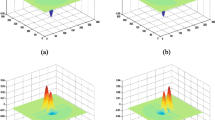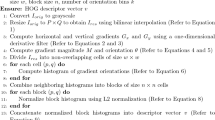Abstract
In this work we investigate appearance-based methods for face recognition on image sequences from large head rotations in depth. We describe the computational difficulties in recognising faces undergoing large pose variations and evaluate the effectiveness of different linear appearance-based methods for the problem. A framework for modelling nonlinear face pose density distributions using Gaussian mixtures was proposed for face recognition under such conditions using general and modified Hyper Basis Function networks.
Preview
Unable to display preview. Download preview PDF.
Similar content being viewed by others
References
P. Belhumeur, J. Hespanha, and D. Kriegman. Eigenfaces vs. fisherfaces: Recognition using class specific linear projection. In ECCV, Cambridge, England, 1996.
R. Bellman. Adaptive Control Processes: A Guided Tour. Princeton Press, 1961.
H. Bülthoff, S. Edelman, and M. Tarr. How are three-dimensional objects represented in the brain? AI Memo 1479, MIT, Cambridge, Massachusetts, April 1994.
I. Craw. A manifold model of face and object recognition. In Cognitive and Computational Aspects of Face Recognition, pages 183–203. Routledge, London, 1995.
A. Dempster, N. Laird, and D. Rubin. Maximum likelihood from incomplete data via the em algorithm. Journal of the Royal Statistical Society, B-39(1):1–38, 1977.
K. Etemad and R. Chellappa. Discriminant analysis for recognition of human face images. In Int. Conf. on Audio-and Video-Based Biometric Person Authentication, pages 127–142, Crans-Montana, 1997.
I. Gath and A.B. Geva. Unsupervised optimal fuzzy clustering. IEEE Transactions on Pattern Analysis and Machine Intelligence., 11(7):773–781, July 1989.
G. Golub and W. Kahan. Calculating the singular values and pseudo-inverse of a matrix. SIAM Numerical Analysis, 2(2):205–224, 1965.
S. Gong, S. McKenna, and J. Collins. An investigation into face pose distributions. In Proc. 2nd Int. Conf. on Automatic Face and Gesture Recognition, 1996.
N.K. Logothetis, J. Pauls, and T. Poggio. Spatial reference frames for object recognition: Tuning for rotations in depth. AI Memo 1533, MIT, Cambridge, 1995.
S. McKenna and S. Gong. Tracking faces. In Proc. 2nd Int. Conf. on Automatic Face and Gesture Recognition, Killington, Vermont, October 1996.
G.W. Milligan and M.C. Cooper. An examination of procedures for determining the number of clusters in a data set. Psychometrika, 50(2):159–179, June 1985.
J.E. Moody and C.J Darken. Fast learning in networks of locally-tuned processing units. Neural Computation, 1(2):281–294, 1989.
R.P. Nikhil, J.C. Bezdek, and C.-K. Tsao, E. Generalized clustering networks and kohenen's self-organizing scheme. IEEE Transactions on Neural Networks, 4(4):549–557, July 1993.
A. Pentland, B. Moghaddam, and T. Starner. View-based and modular eigenspaces for face recognition. In IEEE CVPR, Seattle, July 1994.
T. Poggio and S. Edelman. A network that learns to recognize three-dimensional objects. Nature, 343, January 1990.
T. Poggio and F. Girosi. Networks for approximation and learning. Proceedings of The IEEE, 78(9), September 1990.
K. Sung and T. Poggio. Example-based learning for view-based human face detection. Technical Report AI Memo 1512, CBCL 103, MIT, 1995.
D. L. Swets and J. Weng. Discriminant analysis and eigenspace partition tree for face and object recognition from views. In Proc. 2nd Int. Conf. on Automatic Face and Gesture Recognition, pages 192–197, 1996.
M. Turk and A. Pentland. Eigenfaces for recognition. J. of Cognitive Neuroscience, 3(1), 1991.
L. Xu, A. Krzyzak, and E. Oja. Rival penalized competitive learning for clustering analysis, rbf net and curve detection. IEEE Transactions on Neural Networks, 4(4):636–649, July 1993.
Author information
Authors and Affiliations
Editor information
Rights and permissions
Copyright information
© 1997 Springer-Verlag Berlin Heidelberg
About this paper
Cite this paper
Gong, S., Ong, EJ., Loft, P.J. (1997). Appearance-based face recognition under large head rotations in depth. In: Chin, R., Pong, TC. (eds) Computer Vision — ACCV'98. ACCV 1998. Lecture Notes in Computer Science, vol 1352. Springer, Berlin, Heidelberg. https://doi.org/10.1007/3-540-63931-4_277
Download citation
DOI: https://doi.org/10.1007/3-540-63931-4_277
Published:
Publisher Name: Springer, Berlin, Heidelberg
Print ISBN: 978-3-540-63931-2
Online ISBN: 978-3-540-69670-4
eBook Packages: Springer Book Archive




